
Original Link: https://www.anandtech.com/show/4989/ibuypower-professional-series-reversal-of-fortune
iBuyPower Professional Series: Reversal of Fortune
by Dustin Sklavos on October 21, 2011 1:15 AM ESTWhen it comes to buying a pre-built desktop for the average consumer or gamer, about the only thing the big box manufacturers really have going for them is price. That hasn't stopped them from doing very well, but oftentimes the end user will be better off going to a boutique like iBuyPower for their desktop and enjoying the generally superior build and component quality along with better customer service.
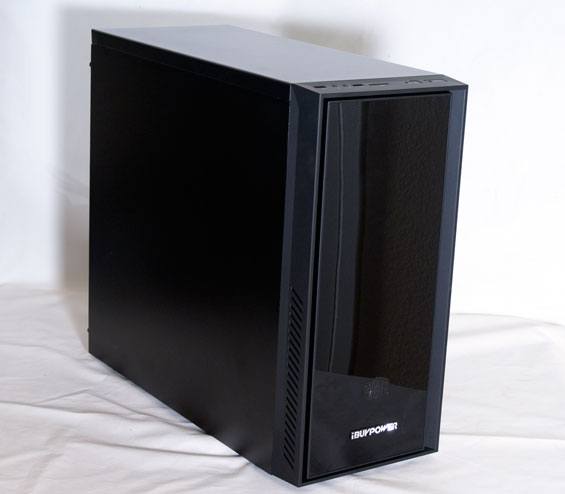
But for small business and enterprise, it can be a whole different ball game, where powerhouses like Dell and HP produce uniquely designed configurations meant for mass deployment...and have the resources to greatly improve support, to boot. We've seen business class machines from both vendors before, but today we have on hand iBuyPower's Professional Series desktop.
Any boutique would probably be remiss to not at least offer some kind of professional solution to end users, and in fact some (like AVADirect) can produce a healthy business going this route by leveraging their own agility in terms of component selection, producing custom builds that bigger OEMs simply aren't readily capable of. Yet the first warning sign comes from iBuyPower's own website, where their Professional Series towers aren't immediately presented; the front page is nothing but gaming machines. In fact you have to hit their "Featured Product" section under the "Desktop" button at the top of the page to even see this line; it doesn't show up under their "Intel Desktop" header. iBuyPower clearly knows who and where their bread and butter are, but a little more publicity for this line could probably go a long way.
For their custom workstation desktops, iBuyPower offers three base configurations, in X58, Xeon (LGA 1155), and Z68 flavors. They shipped us the Xeon version for review, and that's probably the best choice, but what's surprising is how closely this configuration mirrors the HP Z210 we reviewed recently, a desktop that's maybe a third the size of this tower.
| iBuyPower Professional Xeon Specifications | |
| Chassis | Cooler Master Silencio 550 |
| Processor |
Intel Xeon E3-1240 (4x3.3GHz + HTT, 32nm, 8MB L3, 80W, no IGP) |
| Motherboard | ASUS P8B WS (C206 chipset) |
| Memory | 2x4GB Kingston DDR3-1333 ECC @ 1333MHz (expandable to 16GB) |
| Graphics |
NVIDIA Quadro 600 1GB DDR3 (96 CUDA Cores, 640/1280/1600MHz core/shaders/RAM, 128-bit memory bus) |
| Hard Drive(s) | 2x Hitachi Deskstar 7K1000.C 1TB 7200-RPM SATA 3Gbps in RAID 1 |
| Optical Drive(s) | DVD+/-RW Combo Drive |
| Networking | Dual Intel 82579LM Gigabit Ethernet |
| Audio |
Realtek ALC892 HD Audio Speaker, mic/line-in, surround jacks for 7.1 sound S/PDIF and Optical Out |
| Front Side |
Optical drive Hot-swappable 3.5" drive bay |
| Top |
USB 3.0 Headphone and mic jacks USB 2.0 SD Card reader |
| Back Side |
PS/2 6x USB 2.0 6-pin FireWire USB 3.0 2x Ethernet DVI-D (not active) Optical and S/PDIF Speaker, mic/line-in, surround jacks DVI-D and DisplayPort eSATA 2x USB 2.0 |
| Operating System | Windows 7 Professional 64-bit SP1 |
| Dimensions | 8.3" x 17.8" x 19.9" (WxDxH) |
| Extras |
SD Card Reader RAID 1 Corsair TX650 80 Plus Bronze PSU USB 3.0 support Asetek 550LC liquid CPU cooler |
| Warranty | 3-year parts, 1-year labor (extendable by up to two years on each) |
| Pricing |
Starts at $1,389 Review system configured at $1,439 |
The HP Z210 SFF we reviewed shares its core with iBuyPower's configuration: the only difference between the Xeon E3-1240 in our review system and the E3-1245 in HP's is support for Intel's IGP. Likewise, both offer 8GB of ECC DDR3-1333, though iBuyPower opts for two 4GB sticks instead of four 2GB sticks. The NVIDIA Quadro 600 (basically a workstation-class GeForce GT 430) also remains consistent.
Where iBuyPower benefits is by being able to employ a full ATX motherboard complete with all the modern trimmings: USB 3.0, FireWire, dual gigabit ethernet, and even surround sound. They also up the ante by equipping the iBuyPower Pro with a mirrored RAID and a liquid cooler for the processor; the former can be indispensible while the latter is of much more questionable value. What I can't understand is why they elected to eschew including an SSD with this configuration; in fact only their X58 model includes an SSD standard.
Our review unit also only deviates from the iBuyPower stock configuration by using the Cooler Master Silencio 550 enclosure; the stock configuration uses NZXT's Source 210. The Cooler Master case adds $50 to the configuration price but I'm honestly not sure it's worth it, and unfortunately none of the enclosure options iBuyPower offers seem suitable for a workstation.
Ultimately, though, this configuration winds up being a bit over three bills south of the HP system we tested for a bit more flexibility in the hardware, both in terms of configuring your build and actual I/O, and while HP's Z210 tops out at the Quadro 600, iBuyPower will let you upgrade all the way up to a Quadro 5000.
Application and Futuremark Performance
While PCMark is liable to show the HP Z210 SFF barrelling past iBuyPower's Professional Series desktop (due to the Z210's SSD), most other metrics should have the two systems occupying roughly the same space. What will be of particular interest later on will be seeing how much power the two consume in the process. Meanwhile the Dell Precision T1600 is in a different class from these two, costing nearly a grand more than iBuyPower's desktop and offering both a faster graphics card and a faster processor.
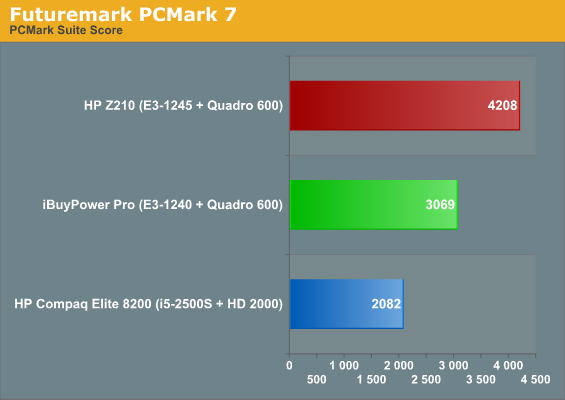
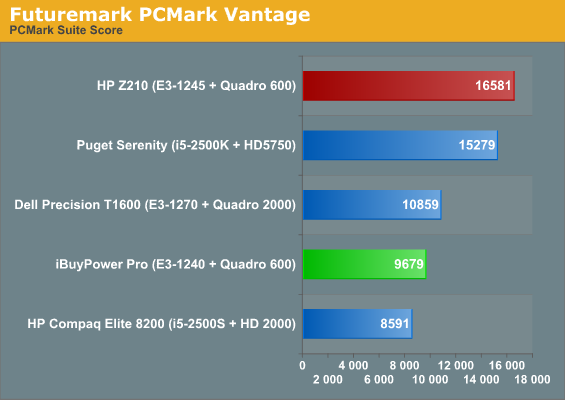
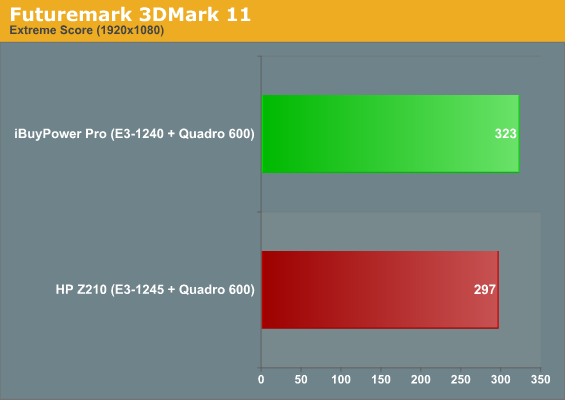
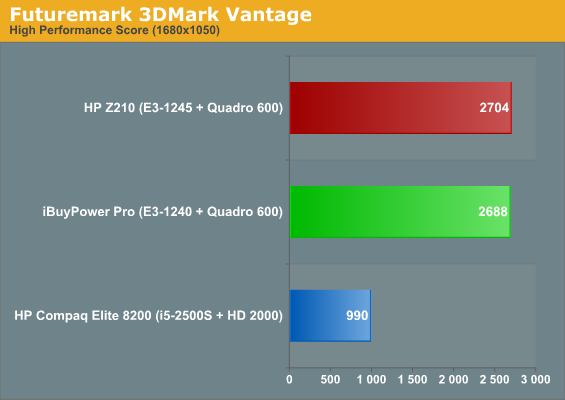
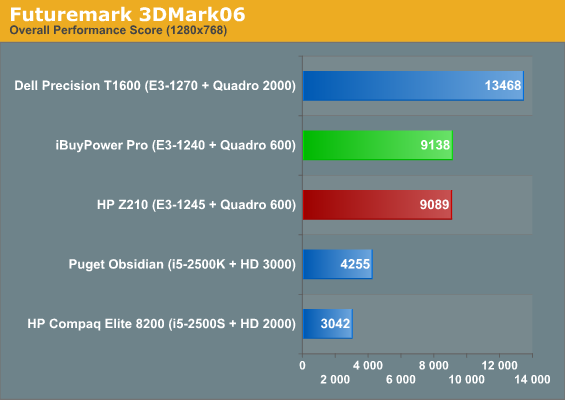
Once we escape the PCMarks, HP's advantage narrows considerably. The two systems are, for all intents and purposes, tied in CPU and GPU performance. What the PCMark scores do reveal is the difference in user experience for day to day use, though; mechanical hard disks in a mirrored RAID just aren't going to feel as snappy and responsive as an SSD for the system disk. At the same time, however, iBuyPower's mirrored RAID does make the system more resilient to drive failure, conceivably allowing for increased uptime. Your mileage may vary, but it's something to keep in mind.
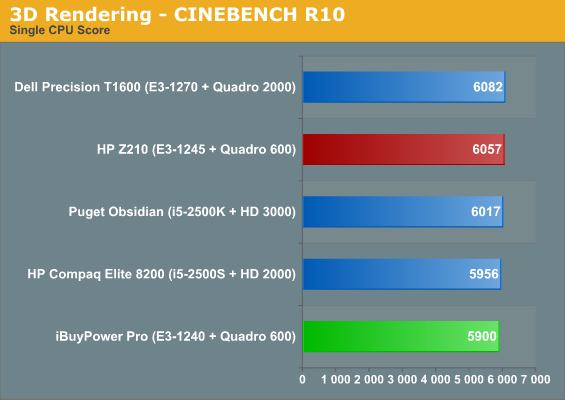
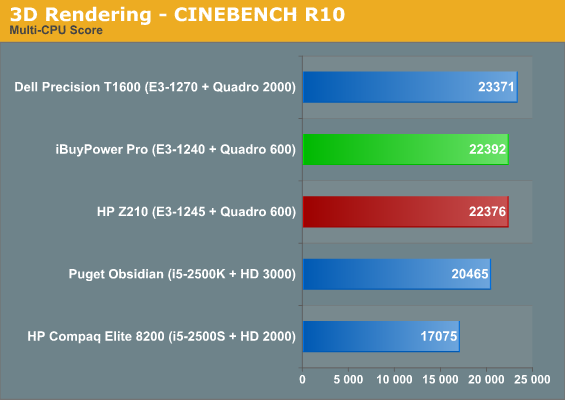
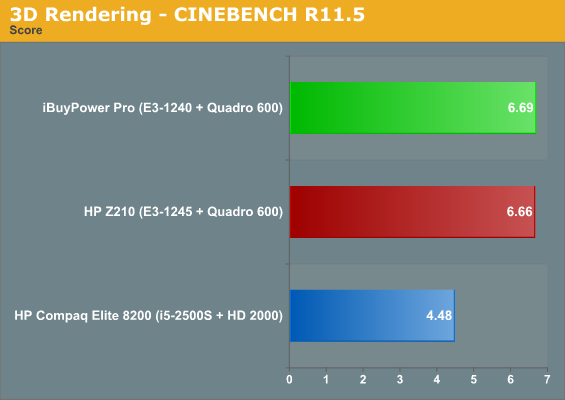
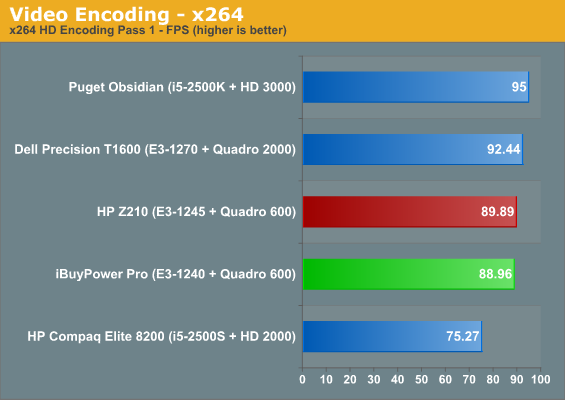
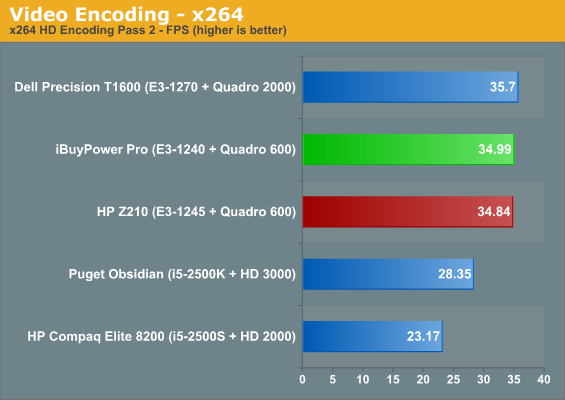
Once again, our CPU-limited tasks find iBuyPower's system essentially comparable with the other Xeon-based systems. Note how the lack of Hyper-Threading takes its toll on the desktop Core i5-based systems: for workstation tasks this feature offers a tremendous improvement in performance.
Gaming and Workstation Performance
Per our workstation reviews, our examination of gaming performance is going to be cursory at best. While these cards can certainly run games, they're not exactly ideal for gaming scenarios, nor were they ever really meant to be used in that fashion. I've included the results from a very inexpensive gaming system from War Factory to give you some idea of how these two classes of desktop really separate from one another.
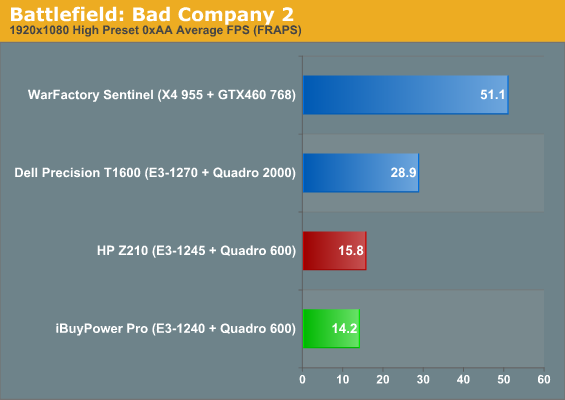
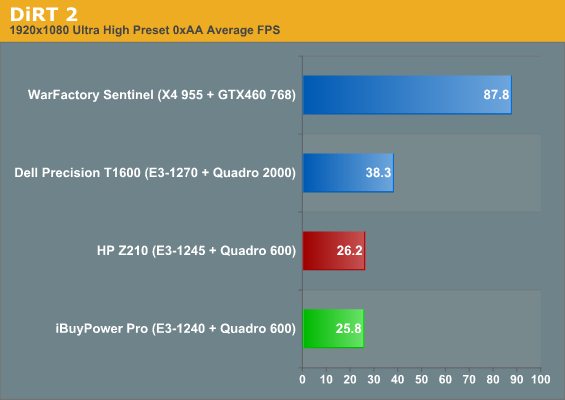
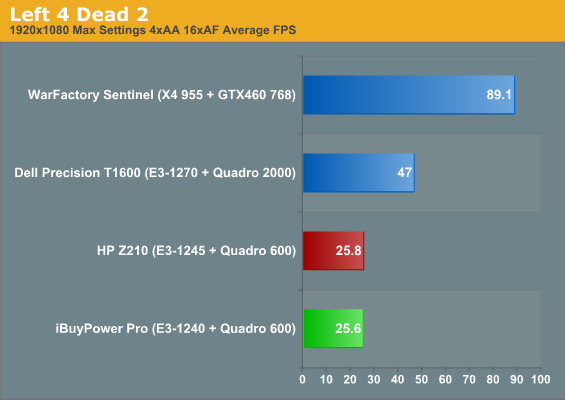
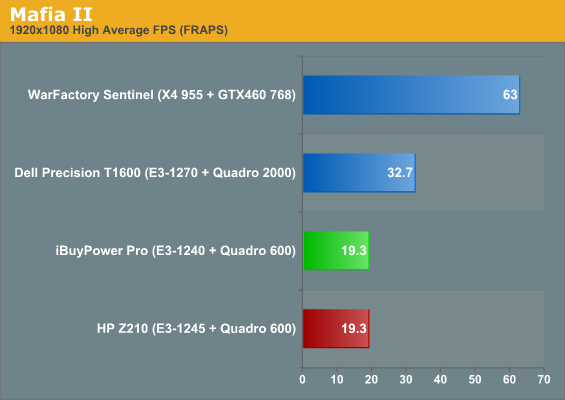
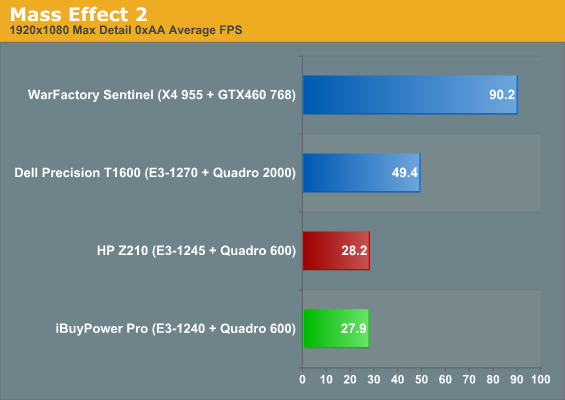
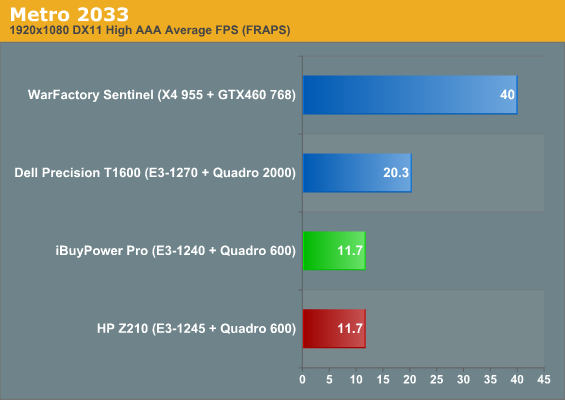
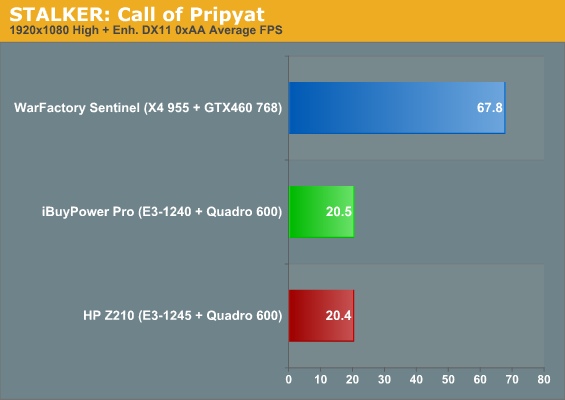
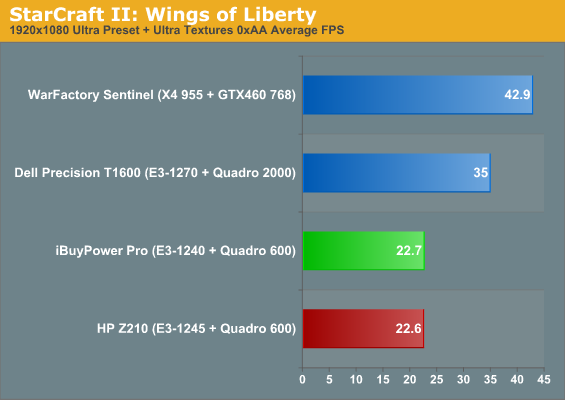
You can see the NVIDIA Quadro 600 just isn't a gaming GPU, and the Quadro 2000 doesn't fare a whole lot better. People buying these "entry-level" workstation cards and planning on doing any kind of serious gaming with them are bound to be disappointed. As you'll see in our workstation benchmarks, though, there's a very good reason for opting to spend up on one of these.
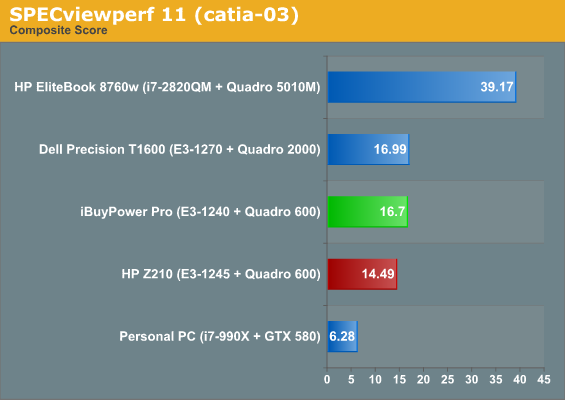
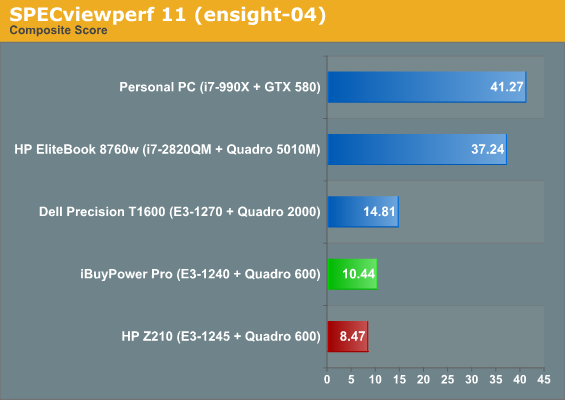
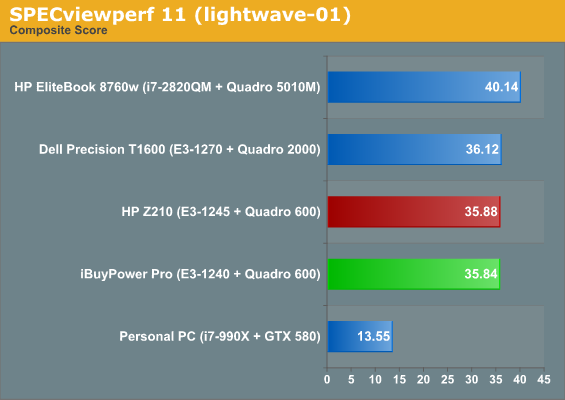
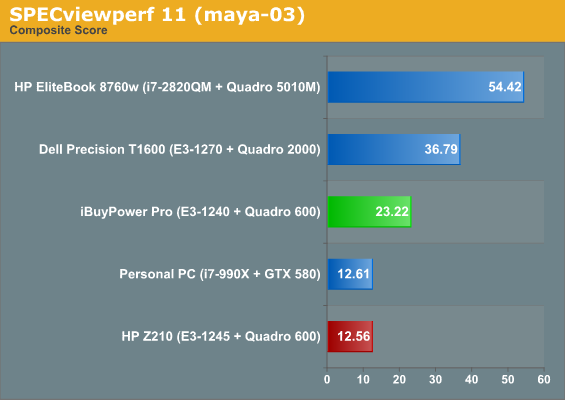
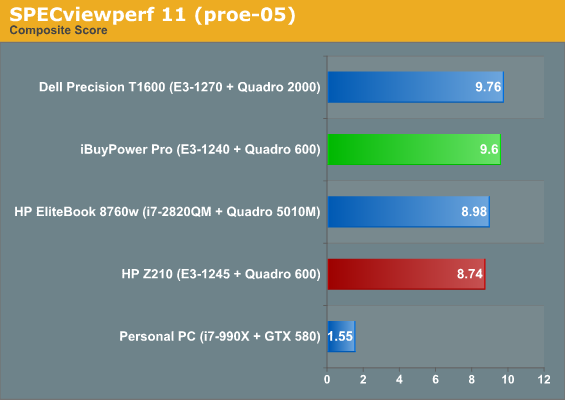
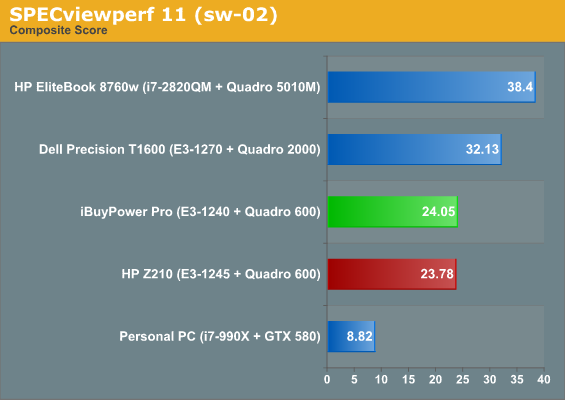
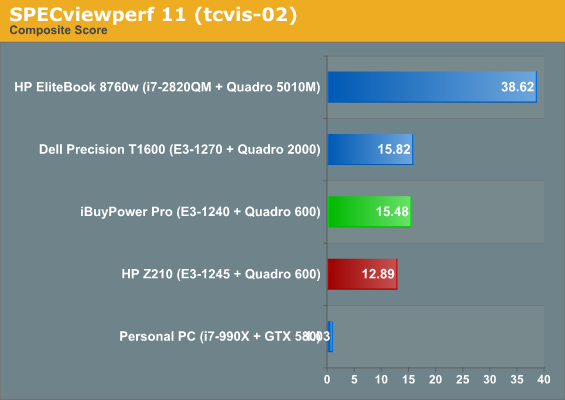
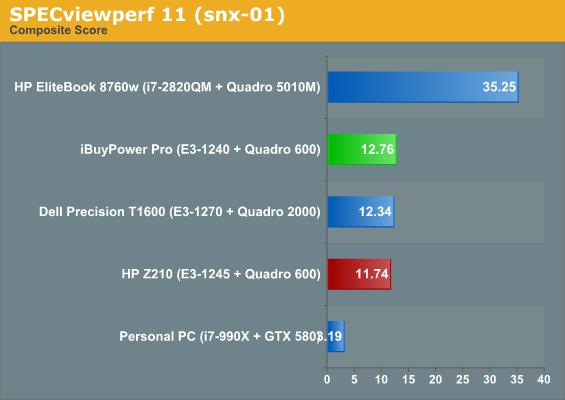
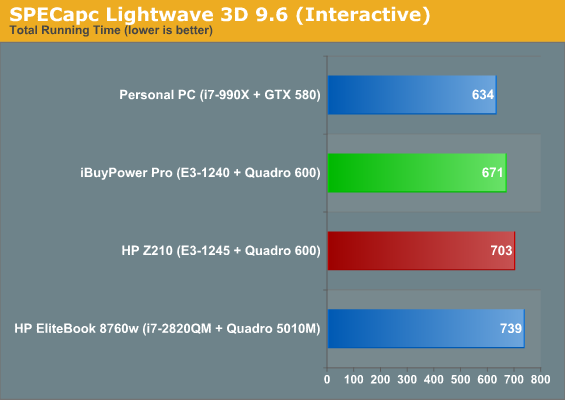
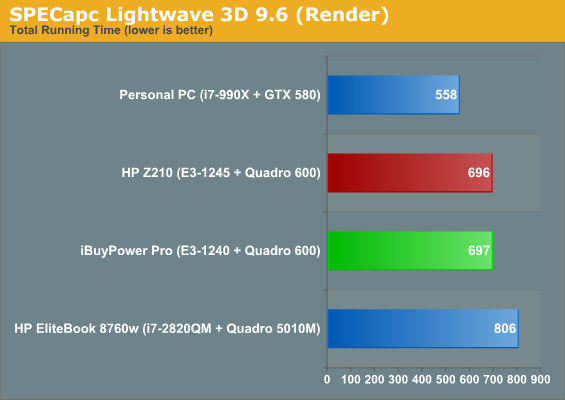
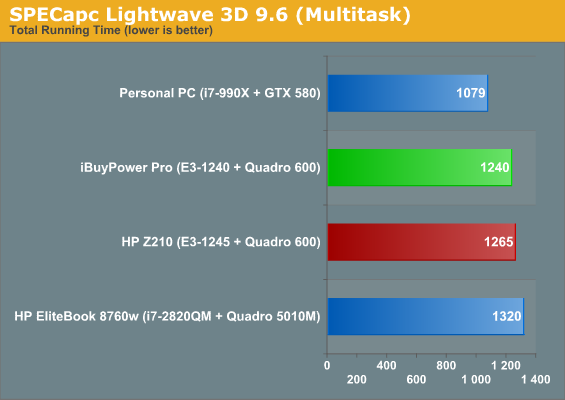
Strangely enough, while the Z210 and iBuyPower systems should outright tie in almost every discipline, iBuyPower's desktop does take a slight lead in most cases and in the Maya portion of SPECviewperf nearly doubles the Z210's results. These differences could theoretically be chalked up to driver performance, but that's one area where HP should have an advantage: iBuyPower doesn't have anything comparable to HP's Performance Advisor.
Once again I'm keen to point out that while a desktop NVIDIA GeForce GTX 580 may feature substantially more raw performance in hardware, the tuning that goes into producing a workstation card (at least on the driver side) justifies the increased cost of the workstation card. A desktop GPU just isn't going to cut it for professional OpenGL work.
Build, Noise, Heat, and Power Consumption
Unfortunately, this is the section where iBuyPower's Professional Series falls flat on its face. The smaller custom chassis designs that HP and Dell employ are places where any boutique is going to have a hard time competing, but the Cooler Master Silencio 550 isn't doing iBuyPower any favors.
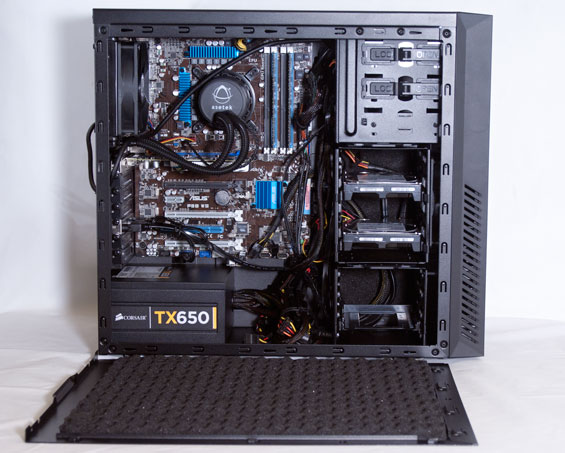
Internal build quality is certainly clean, and the noise dampening materials employed on the insides of the side panels don't hurt. In fact, under load the iBuyPower Pro is borderline inaudible...or at least it should be. The problem is that the hard drives are loud. Not even a little loud, either; they completely overwhelm the rest of the build. They're so close to the ventilation in the front that the noise from them isn't dampened at all, and whenever the iBuyPower Pro hits the RAID 1 you can hear them crunching. There's nothing in the character of the noise to suggest that the drives are malfunctioning, it's just a case of them being too noisy. I have to wonder if opting for a different brand of hard drive wouldn't have been a better choice.
The liquid cooling on the processor also strikes me as overkill. This is a fine checkbox feature for gaming desktops, but in a workstation it's an unnecessary expense. The rest of the enclosure has enough dampening that I don't see how Intel's stock cooler would be that much of a drawback. It's nice for iBuyPower to include this as standard, but in workstation desktops from OEMs it's unnecessary; their custom chassis designs allow them to dissipate heat quietly and efficiently.
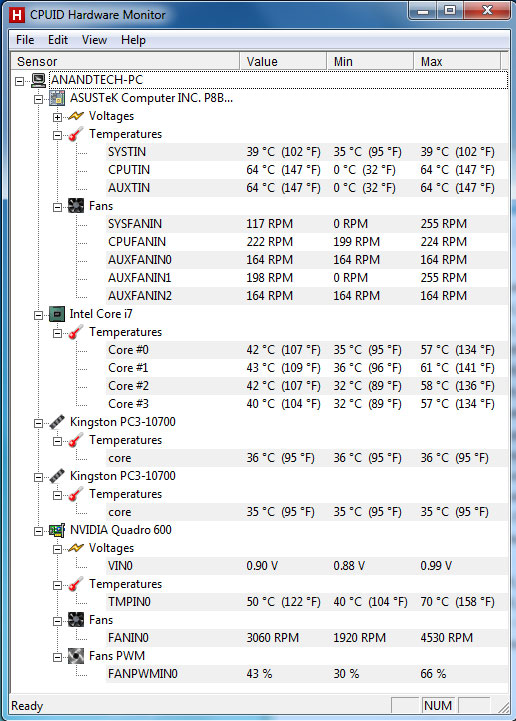
The iBuyPower system's thermals aren't terrible but they still manage to underwhelm. I suspect part of the reason is that the Silencio 550 may have two intake fans in the front, but with the front door closed there's virtually no way for air to get into those fans. It runs into the same problem NZXT's H2 does. For a system with a mid-tower enclosure and liquid cooling on the processor, you'd expect a little bit better. The temperatures on the Quadro 600 in particular aren't great; 70C under load seems a touch high for such an underpowered card in a relatively open case.
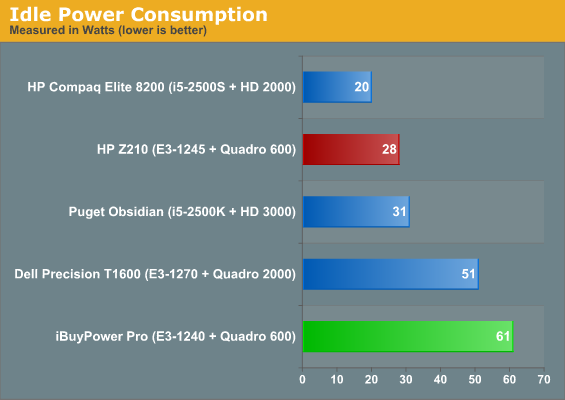
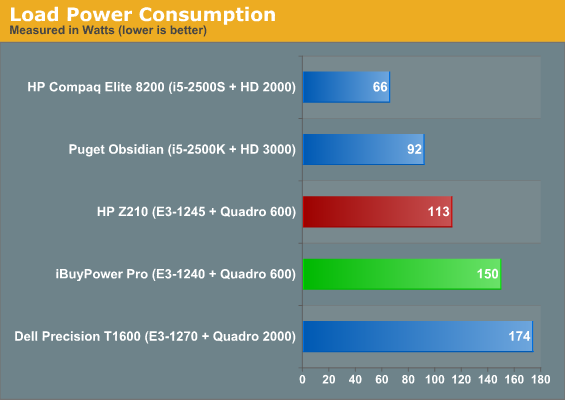
Idle consumption of 61 watts certainly isn't bad for a desktop, but every other system we've tested does better, and HP's system is able to run at half that. The bigger case, bigger motherboard, liquid cooler, and dual hard drives take their toll on power consumption. It's only when we get to load power that Dell's significantly faster Precision T1600 pulls more juice, and even then it's not a massive gulf. For roughly the same performance, HP's Z210 pulls less than half the power at idle and 75% of it at load.
Conclusion: Feels Like an Afterthought
I want to be clear: the iBuyPower Professional Series isn't necessarily a bad computer. It'll certainly get the job done, and iBuyPower allows for enough custom configuring to make it worth your while. Being able to upgrade to faster NVIDIA Quadro GPUs is a decent incentive to go this route, and iBuyPower definitely competes on price.
The problem is that I just don't see any reason to buy it over competing systems from Dell or HP. In the case of the HP Z210 SFF we compared it to, HP's system is smaller, quieter, offers better power consumption, and probably most damning, has a superior warranty. If you configure HP's unit without the SSD, you can drive the cost down to compete with iBuyPower's selection, too. While iBuyPower offers three years of labor, they only offer a year on the parts, utterly inexcusable when individual warranties on each of the parts are going to be at least three years (and in some cases lifetime). HP starts at three years of labor, three years on parts, and three years of on-site service, that last point being something iBuyPower just isn't big enough to compete on.
There's very little going on with the iBuyPower Pro that makes me feel like it was configured by someone who understood the needs of enterprise users. This feels like a desktop where consumer parts were swapped out in favor of enterprise parts, and that's about it. The Corsair TX650 power supply is fantastic...for a gaming machine. Here it's overkill. The same is true of the Asetek liquid cooler, which as I mentioned before is more of a checkbox inclusion than something that actually adds value to the machine. The Xeon isn't being overclocked and has no need for exotic cooling. And the Cooler Master Silencio 550 enclosure is just the best from a series of consumer-oriented case choices; this should've been an Antec Solo II or SilverStone Temjin TJ08-E, something that would actually look like it belonged in an office.
I know boutiques have ways of competing with big box OEMs when it comes to building workstation desktops, but this isn't it. The fact that these towers are buried on iBuyPower's site suggests they're either not big sellers or just not that important to iBuyPower's business, and that's a shame. Other boutiques have embraced this potentially lucrative market (we'll be seeing more offerings from those boutiques in the future), and for iBuyPower to dismiss it with a machine like this is unfortunate. They can do better. Hopefully we'll see that in a future system.












